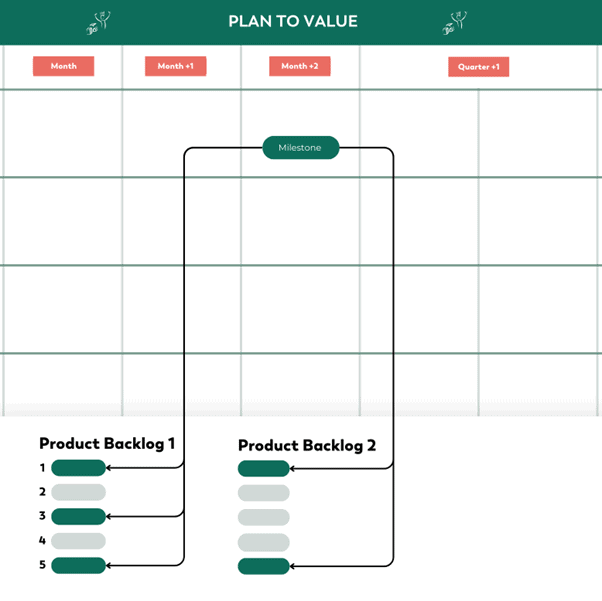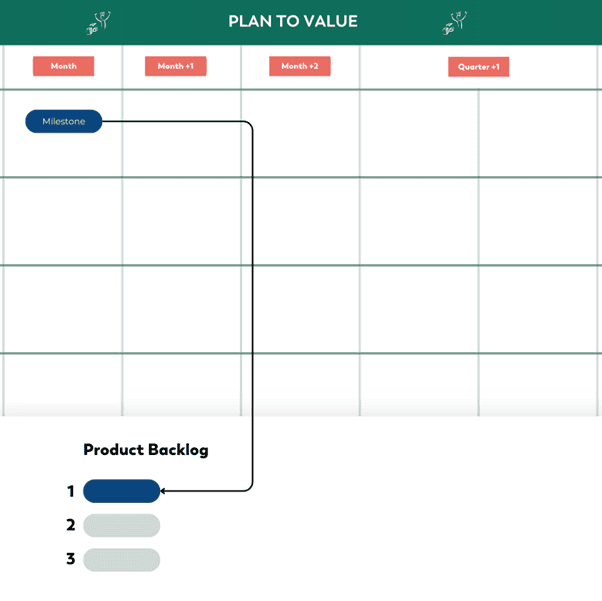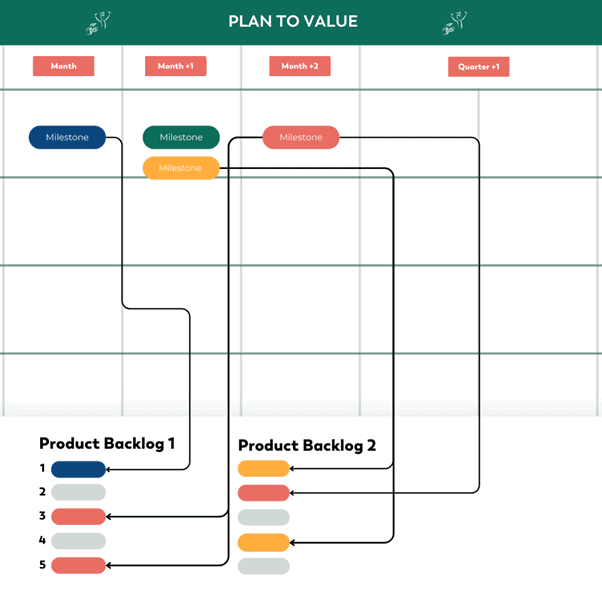
Introduction
Within agile ways of working, connecting between the Obeya Plan to Value and Product Backlogs is important. Both contain valuable products or output to be prioritized and delivered, but in a different setting. Let us delve into the interplay between these artifacts, shedding light on how they synergize.
By Mark Uijen de Kleijn – 14 sept 2023
The Role of Obeya Plan to Value
The Plan to Value area of the Obeya – where the Leading with Obeya method is applied – shows what steps we need to take as a team in order to reach our goals. Within these steps, we determine how our scarce means and people can best be deployed to create value. This value encompasses both external customer value and the growth of the organization and team internally, all while taking a holistic system-wide approach. Through milestones, we visualize the value of our actions and agree and align upon how we reach that value, setting clear expectations with the team and for its stakeholders. The Plan to Value is visually connected to the Strategic Capabilities and Performance Indicators, with milestones connected to Performance Indicators to facilitate improvements and follow up on (business) outcomes. Ultimately, the goal of Plan to Value is to see, act & learn together as a leadership team to maximize value for our (internal) customers.
The milestones on Plan to Value represent what we really need to talk about as a leadership team. This depends per team, e.g. on size of the organization, maturity of the organization, type of products we create etc. Most important is that the team together creates and decides what needs to be talked about, and makes this visual. The Plan to Value area is therefore a way of communication, it is not the administration of all the work that we do. The Plan to Value area is usually some visual planning board*, connected to the other areas of the Obeya, representing the milestones that the leadership team needs to talk about.
How is Plan to Value connected to the Product Backlog(s) of product(s)?
In Agile environments, Product Backlogs are an emergent, ordered list of the potential future work that needs to be done for the product. The Product Owner orders this list and the team(s) work from the top of the list to create the work into value.
The Plan to Value area represents the whole system that is relevant to the leadership team, which often consists of multiple products (and Product Backlogs). This also includes e.g. creating an engaging workplace, improving operations, marketing, sales, very much depending on the context. Milestones on the Plan to Value area might be on multiple Product Backlogs, but some milestones on the Plan to Value area might not be on any Product Backlog. These milestones could be on improvement boards of non-agile teams, or leadership team members have a milestone to improve the work environment.
A leadership team close to the actual work likely has a more direct connection to Product Backlogs compared to a leadership team that leads a large organization or a department consisting of many products or services. Often, their milestones cascade to more detailed level Obeya’s which have more detailed milestones as a consequence. These detailed milestones are obviously more directly connected to the Product Backlog Items.
Diverse links between Plan to Value and Product Backlogs
We will now discuss 5 ways in which a milestone and a product backlog item can be linked.
1-on-1 connection
A milestone on Plan to Value might be 1) that clear and small or 2) very important for the leadership team that a single Product Backlog Item on the Product Backlog is connected to a single milestone in the Plan to Value area. It’s a relatively less common connection, because too many such connections can lead to excessive detail within the Plan to Value. It might happen for some milestones, but for most milestones this will not be the case.

1 milestone on Plan to Value is connected to multiple Product Backlog Items on the Product Backlog
A more common possibility is that multiple Product Backlog Items from the Product Backlog are connected to a single milestone in the Plan to Value area. For the leadership team, it’s important to talk about, align, and set expectations for the final or larger milestone that represents value. On the Product Backlog this could entail multiple Product Backlog Items, often exceeding the three-limit used here as an example. For instance, within the Plan to Value area, it’s relevant to talk about the MVP or market launch, despite the iterative work required to reach the milestone. Communication about the milestone within the Plan to Value often doesn’t require the same level of detail present in the Product Backlog.

1 milestone on Plan to Value is connected to multiple Product Backlog Items from multiple products’ Product Backlog
A variation of the previous option emerges when multiple products are in scope of the leadership team. In this case, the milestone might be connected to multiple Product Backlog Items spanning multiple products and/or teams, all of which collectively contribute to the value that is represented by the milestone.

Plan to Value milestones beyond Product Backlogs
The Plan to Value board focuses on the tactical and strategic plan of the management or leadership team. It therefore focuses on the delivery of the most relevant parts of the backlog, but may also contain e.g. planning cycles, annual or quarterly reports, relevant events, deadlines for external regulations and more, which are not reflected in Product Backlogs. The Plan to Value not only visualizes these milestones but also ensures communication and strategic visibility, empowering see, act & learn together. The visibility and/or administration might also be on the improvement boards of operations teams, ticketing systems of HR or other places.
Product Backlog Items not visible on Plan to Value
Usually many Product Backlog Items are not visible on the Plan to Value. This has multiple reasons:
- The level of detail in the Product Backlog is too high to effectively talk about in the leadership team.
- The Product Backlog Items are only relevant to a single product and expectations don’t have to be set about these items in the leadership team.
- The Product Backlog Items reflect work on maintaining or improving the product, which only becomes relevant in the leadership team for 1) improvement of performance in the Performance area or 2) when a problem arises that the people from the product cannot solve themselves.
Combined overview of options
A Plan to Value connected to multiple Product Backlogs looks like the following:

Conclusion
Embracing the diverse ways of connecting Plan to Value and Product Backlogs helps leadership teams see, act & learn together about value, while also ensuring empowerment to teams to create the actual value.
These insights will help you and your team. If you have any questions, or if you are interested in getting started with the Leading With Obeya method, we cordially invite you to attend one of our training courses or e-learnings!
* there are other visual representations possible for Plan to Value. However, in an agile way of working there is usually some kind of planning visualization.


